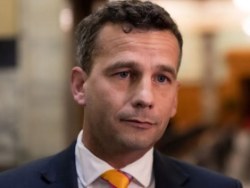Tariana Turia: The Power Of Three
Te Ara Wananga Launch
Te Kohanga Reo National Trust,
Wellington
Wednesday 6 December 2006; 5pm
The Power of Three
Tariana Turia: The Power Of Three
Co-leader, Maori Party
Today we have a celebration of the Power of threes.
Greek philosopher and mathematician, Pythagoras, referred to three as a perfect number; the triangle as the perfect shape. This belief came from a world view in which the world was ruled by three Gods and in turn, the people cherished love, laughter and beauty.
Around the globe, the rule of three weaves its magic.
The Chinese worshipped gentleness, frugality, and humility.
The Mysterious Three of Scandanavia sat on three thrones above the rainbow.
Christians believe in the trinity of Father, Son, and Holy Ghost; and the three graces of Faith, Hope and Charity.
Even at the most mundane level; whether we are animal, mineral, or vegetable; whether it is morning, noon or night; a time of past, present or future; in the midst of breakfast, lunch or tea, there is no doubt that the power of three is compelling.
And so with
today, I greet the three wise men, Wira Gardiner, Matua
Whatarangi Winiata and Bentham Ohia, who have united in
their vision to achieve meaningful collaborative
relationships based on the power of three wananga:
Te
Wananga o Aotearoa
Te Wananga o Raukawa
Te Whare
Wananga o Awanuiarangi
Tena koutou, tena koutou, tena koutou katoa.
You have seized the vision for collaboration – recognizing the strength of diversity as being your most distinctive attribute; building on that diversity and creating a new waka, te ara wananga.
We are
here to celebrate Te Ara Wananga – the Wananga pathway. A
for Aotearoa; R for Raukawa; A for Awanuiarangi. Ara!
It
is a brilliant concept – the cumulative wisdom and
expertise available to graduates of wananga to make choices
from a possible twenty-eight different degrees. The
emphasis is on collaboration, on shared offerings, on
building up collective knowledge through cross-crediting,
and working together.
And why should we be surprised that
it is wananga that once again are leading the way in
establishing innovation and championing excellence?
The Maori Party has always recognised the unique role of wananga as playing a fundamental role in fostering and uplifting te reo me ona tikanga; matauranga Maori; and kaupapa Maori education.
You have been responsible for the remarkable resurgence in Maori participation in tertiary education, rocketing up from 15,000 enrolments in 2001 to 43, 000; trebling its growth, a mere three years later.
In your collaboration you represent the aspirations articulated so eloquently by Potatau Te Wherowhero:
Kotahi ano te kōhao ō te ngira e kuhu ai te miro mā, te miro mangu, me te miro whero.
There is only one eye of the needle, through which the white thread, the black thread and the red thread must pass
One thread has successfully trained thousands of tauira every year, delivering fifty programmes in thirteen subject areas across ten campuses – making it the largest wananga in Aotearoa.
Another thread has created distinctive and cherished tribal histories through iwi and hapu studies; through strengthening the capacity to know ourselves better as Maori, Te Kakano i ruia mai i Rangiatea.
And another thread, while firmly rooted in Mataatua, is branching out into te Wheke a Toi – the octopus of toi – reaching out into the international world for ideas and knowledge.
Together, the three wananga have stood firmly to revitalize our taonga; to breathe energy into our reo rangatira; to encourage our whanau to live by kaupapa tuku iho.
It is a pathway driven by success.
Success in acknowledging ahuatanga Maori as valid; in providing opportunities for Maori ways of teaching and research to advance knowledge through te Ao Maori and beyond.
It is success which reaches across all spheres of understanding. If we think of completion rates, it is to be noted that the highest five year completion rates for Maori students at level four were at wananga (58%) and the lowest at universities (13%). So clearly there is something in the formula offered by wananga that grabs our people, and won’t let them go.
Even the Ministry of Education had to acknowledge, begrudgingly, that Te Wananga o Aotearoa should be praised for its retention rates.
The percentage of Maori students involved in post-graduate study is increasing every year.
But I think the hallmark of success that means the most, is the mark you are making in our whanau, hapu and iwi aspirations. The pursuit of their tohu at wananga, is charging up our people in ways which are rewarding way beyond expectations.
The compulsive attraction of intellectual stimulation is located firmly in the warmth of the whakawhanaungatanga; the embrace of manaakitanga.
Our marae, history, waiata tawhito; taonga; our worlds are recognized and valued.
Papatuanuku and Ranginui are cherished as integral to the depth of our knowledge. Within the context of environmental studies, we acknowledge wananga as truly working towards the creation of Genuine Progress Indicators for a new Aotearoa.
The meteoric rise of the three wananga has not been without its costs however, and we have all experienced the wrath of ritualized racism, as a multitude of politicians and select committee reports and Ministry reviews and audits have sought to focus on conflicts of interest, on governance and financial reporting; and more recently on quality and relevance.
I am reminded of former British Prime
Minister, in his legendary challenge to the citizens of
England during the Battle of Britain:
We shall fight them
on the beaches,
we shall fight them in the streets,
we
shall fight them in our homes,
we shall never, never,
never sur-render.
What we have seen over these last
turbulent years, is that indomitable spirit that has
characterized the three wananga, as you have never, never,
never surrendered in the face of adverse criticism.
But your fight has been a fight for survival, a fight for revival, the outcome always being the sustained renaissance and resurgence of te Ao Maori. And that fight will continue as we work together to harness the potential of all our peoples.
We must never forget the origins ofTe Wananga o Aotearoa which started in 1983 running trade training courses in a corrugated iron shed on a former rubbish tip site in Te Awamutu.
It grew from such humble beginnings to contribute up to 2% of the country’s Gross Domestic Product with an enormous national economic and social impact.
Two years earlier, in 1981,
Raukawa Trustees invested in hope, and created a wananga in
Otaki as part of the Whakatupuranga Rua Mano
programme.
In those earthy days of establishment,
classrooms evolved wherever a space could be found. Colin
Knox remembers teaching a class in the kauta of the old
wharekai at Raukawa marae. Five students was considered a
good-sized class, and if they got ten they celebrated.
Girlfriends and boyfriends, aunties and koros would come and
sit in the classes to see why their whanaunga would want to
spend their weekend inside doing school work.
Although the teina, Te Whare Wananga o Awanuiarangi too shares the rags to riches success story of the other two threads. You have pioneered new pathways, indeed paving the way to this day, with the unique joint venture arrangement with Te Ataarangi and with your focus on innovation.
And I am, of course, impressed by Awanuiarangi’s logo
of the upturned triangle, representing whanuitanga (breadth
of knowledge) along the top and hohonutanga (depth of
knowledge).
No celebration of this collaboration could be
complete without acknowledging the sheer dedicated
commitment, the expertise, the leadership of those who have
inspired these three wananga onwards. Matua Whatarangi;
Turoa Royal; Rongo Wetere; Hirini Moko Mead; Gary Raumati
Hook; Bentham Ohia; Wira Gardiner; Ruakere Hond, Linda
Smith; Graham Smith and many others, have all been part of
the dream that we honour today.
And it is absolutely
fitting that in the esteemed company of Dr Timoti Karetu and
Professor Wharehuia Milroy, we honour the lifelong passion
and commitment of the one and only Iritana
Taiwhiwhirangi.
Today is a day for champions, and for
celebration.
It is a day to savour what we aspire to be, what we can be, and what we will be, through the unique pathways provided by the wananga. I thank you, for the opportunity and for the utmost honour of being able to share this incredible opportunity – the blossoming of our renaissance.
It is moments like this – when we see the combined power of kohanga reo; of our renown language experts; of our leading academics; our cultural icons; and such beautiful people – that we know Te Kakano i ruia mai i Rangiatea is in very good hands.
Ends


 Gordon Campbell: On Iran Killing Its Rappers, And Searching For The Invisible Dr. Reti
Gordon Campbell: On Iran Killing Its Rappers, And Searching For The Invisible Dr. Reti Labour Party: National Should Heed Tribunal Warning And Scrap Coalition Commitment With ACT
Labour Party: National Should Heed Tribunal Warning And Scrap Coalition Commitment With ACT Government: Saves Access To Medicines
Government: Saves Access To Medicines Office of the Speaker: Law And Order, Finance, And Defence A Focus For Ukrainian Parliamentary Delegation To NZ
Office of the Speaker: Law And Order, Finance, And Defence A Focus For Ukrainian Parliamentary Delegation To NZ Environmental Defence Society: Fast-track Approvals Bill Presents A Serious Risk To New Zealand Exporters
Environmental Defence Society: Fast-track Approvals Bill Presents A Serious Risk To New Zealand Exporters NZ Government: New Lab To Help Protect Key Pacific Tuna Fisheries
NZ Government: New Lab To Help Protect Key Pacific Tuna Fisheries Susan Botting - Local Democracy Reporter: Ruawai Leader Slams Kaipara Council In Battle Over $400k Property
Susan Botting - Local Democracy Reporter: Ruawai Leader Slams Kaipara Council In Battle Over $400k Property


